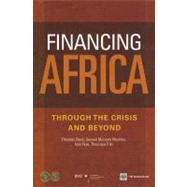
Note: Supplemental materials are not guaranteed with Rental or Used book purchases.
Purchase Benefits
Looking to rent a book? Rent Financing Africa Through the Crisis and Beyond [ISBN: 9780821387979] for the semester, quarter, and short term or search our site for other textbooks by Beck, Thorsten; Maimbo, Samuel Munzele; Faye, Issa; Triki, Thouraya. Renting a textbook can save you up to 90% from the cost of buying.
| Foreword | p. xi |
| Acknowledgments | p. xiii |
| Abbreviations | p. xv |
| Financing Africa: Setting the Stage | p. 1 |
| Introduction | p. 1 |
| Financing Africa, the Book | p. 3 |
| An Analytical Framework | p. 3 |
| The Main Messages and a Caveat | p. 7 |
| Financial Sector Development: Why Do We Care? | p. 9 |
| Time for New Solutions to Old Problems | p. 16 |
| The Outline of the Book | p. 23 |
| Landscaping African Finance | p. 2 |
| Introduction | p. 27 |
| The Effect of the Crisis | p. 27 |
| Africa's Financial Systems in International Comparsion | p. 36 |
| Explaining Financial (Under)Development in Africa | p. 59 |
| The Firm and Household Usage of Financial Services | p. 68 |
| Conclusions | p. 74 |
| Expanding Financial Systems | p. 77 |
| Introduction | p. 77 |
| What Do We Know about Access to Finance? | p. 78 |
| Broadening Finance: A Reality Check | p. 85 |
| Landscaping the Providers: How to Get to the Frontier | p. 88 |
| Demand-Side Constraints | p. 102 |
| Technology: The New Silver Bullet? | p. 105 |
| Pushing Out the Frontier: The Role of Governments and Donors | p. 111 |
| The Role of Government: Looking beyond Institution Building | p. 113 |
| From Agricultural Credit to Rural Finance | p. 119 |
| SME Finance: Continuing Challenges | p. 127 |
| Conclusions | p. 137 |
| Lengthening Financial Contracts | p. 141 |
| Introduction | p. 141 |
| Africa's Long-Term Financing Gap | p. 142 |
| Optimizing the Current Possibilities for Expanding Long-Term Finance | p. 145 |
| Tapping International Markets | p. 164 |
| The Changing Global Environment: Tales of Dragons and Elephants | p. 178 |
| Pushing toward the Frontier and Beyond: A Long-Term Agenda with Tricky Shortcuts | p. 180 |
| Conclusions | p. 190 |
| Safeguarding Financial Systems | p. 193 |
| Introduction | p. 193 |
| Stability: We Have Come a Long Way | p. 194 |
| Bank Regulation and Supervision: New Challenges in a Changing Environment | p. 197 |
| Looking beyond Banks: How to Regulate Which Segments of the Financial System | p. 213 |
| Focusing on Users: Consumer Protection | p. 218 |
| Conclusions | p. 223 |
| All Financial Sector Policy Is Local | p. 227 |
| Introduction | p. 227 |
| Modernist Reform Policies: Africa's Achilles Heel | p. 227 |
| The Activist Reform Agenda Revisited: Larger, More Efficient, and Stable Financial Markets | p. 229 |
| The Politics of Financial Sector Reform | p. 234 |
| The Stakeholders | p. 240 |
| Redefine the Role of Government: with the Necessary Safeguards | p. 245 |
| One Size Does Not Fit All | p. 247 |
| Conclusions | p. 256 |
| References | p. 259 |
| Index | p. 279 |
| Boxes | |
| What's New? | p. 4 |
| Performance on Selected Stock Markets during 2008-09 | p. 31 |
| The Real Economy Impact of the Financial Crisis in Zambia | p. 32 |
| Bank Consolidation: Learning from the Nigerian Experience | p. 45 |
| The Egyptian Exchange | p. 55 |
| Benchmarking Financial Development | p. 66 |
| Measuring Access to Financial Services: Recent Advances | p. 78 |
| Financial Capability Programs | p. 106 |
| Examples of Transformative Technology-Based Products | p. 110 |
| Malswitch | p. 116 |
| Financial Innovation: The Opportunities and Risks in Expanding Outreach | p. 117 |
| Examples of Value Chain Finance | p. 122 |
| Malawi: Development Finance Institutions | p. 128 |
| NAFIN's Productive Chains | p. 135 |
| The Housing Finance Frontier: An Approximation for Africa | p. 146 |
| The Role of the Housing Bank in Mortgage Finance in Tunisia | p. 149 |
| International Labour Organization Best Practice Guidelines for Board Members in Africa | p. 160 |
| The Experience with a Secondary Board in Egypt: Nilex | p. 161 |
| Capital Markets in Latin America | p. 163 |
| Private Equity Funds: The Benefits and Experience in Africa | p. 166 |
| Sovereign Wealth Funds | p. 175 |
| Diaspora Bonds | p. 181 |
| Competition and Stability | p. 203 |
| Bank Resolution | p. 206 |
| The Consumer Protection Framework in South Africa | p. 220 |
| Learning from the East Asian Miracle | p. 280 |
| Financial Journalism | p. 236 |
| What to Do with State Financial Institutions? | p. 248 |
| Table of Contents provided by Ingram. All Rights Reserved. |
The New copy of this book will include any supplemental materials advertised. Please check the title of the book to determine if it should include any access cards, study guides, lab manuals, CDs, etc.
The Used, Rental and eBook copies of this book are not guaranteed to include any supplemental materials. Typically, only the book itself is included. This is true even if the title states it includes any access cards, study guides, lab manuals, CDs, etc.